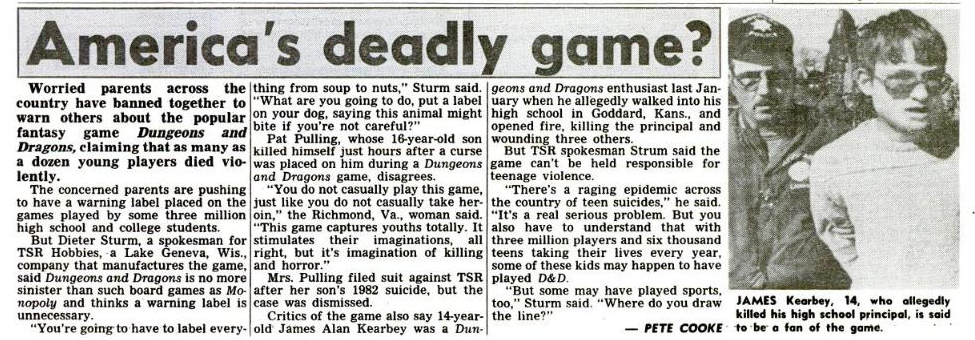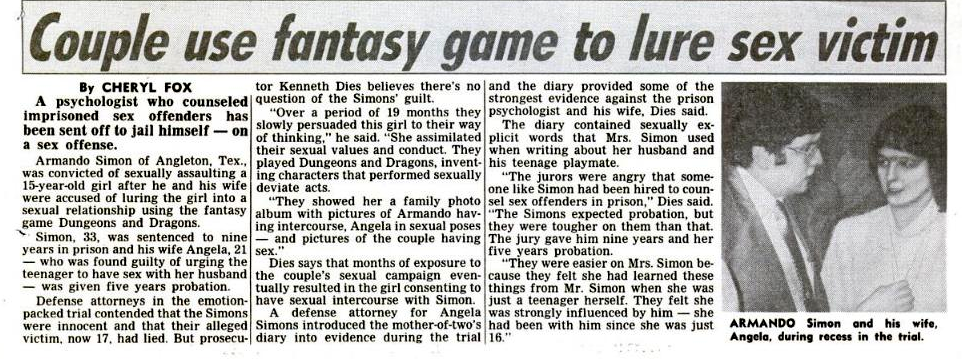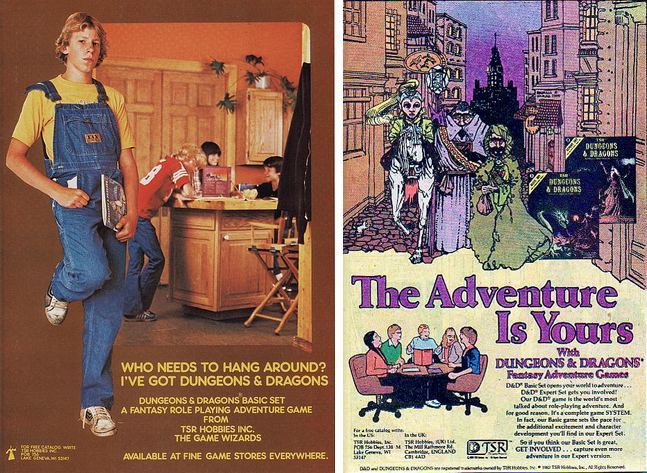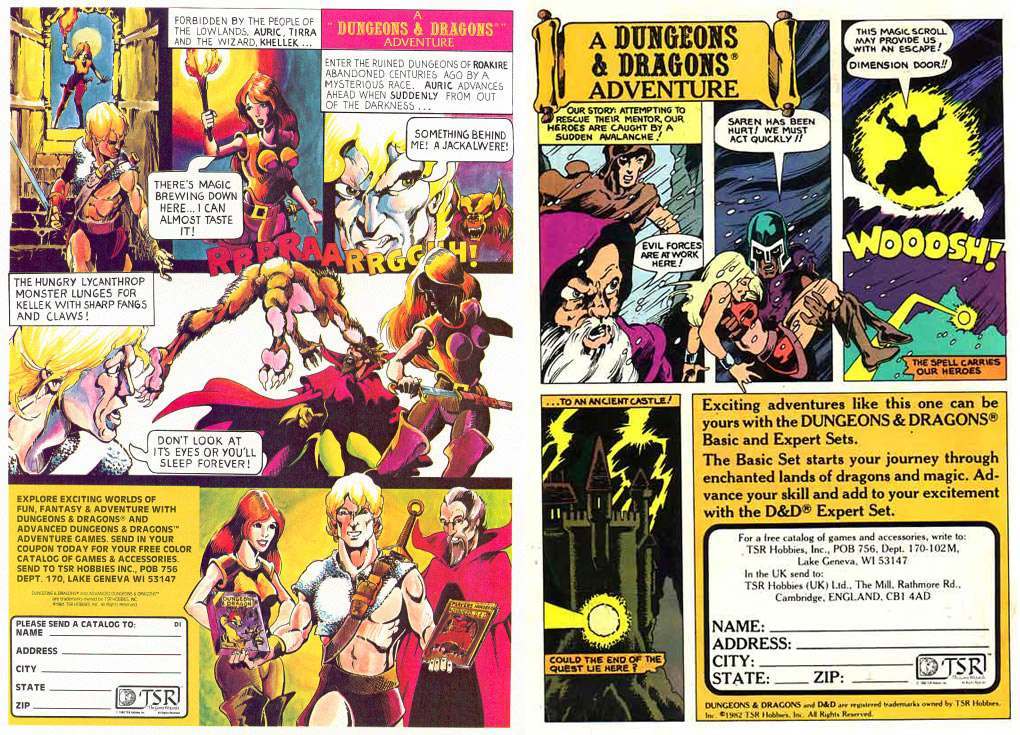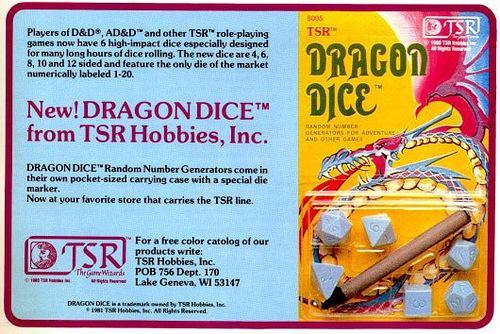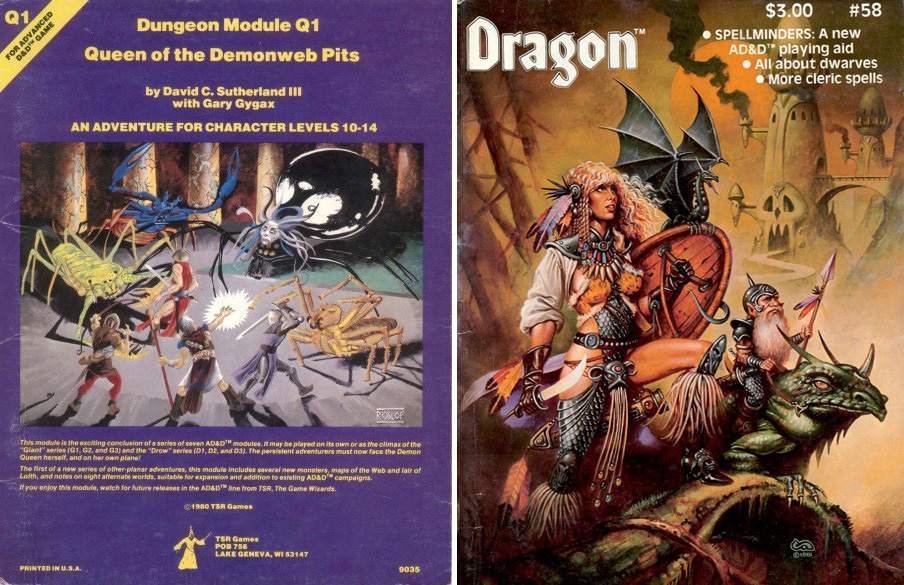Having barely taken a look at Dungeons & Dragons in decades, I’m no expert on its current incarnation. However, it’s clear to see the roll playing game has changed quite a bit in the past thirty years. So, this list doesn’t necessarily apply to today (although, it might) – it’s all about the early 80s variety of D&D (or, more specifically, TSR’s Advanced Dungeons & Dragons), which, for me, will forever be its Golden Age.
1. D&D = Evil
For some high school/junior high kids, illicit activity means going out, getting drunk and smashing mailboxes. But for the more cerebral crowd (i.e. “nerds”), D&D was a more enjoyable form of rebellion.
What’s so rebellious about rolling dice and fighting imaginary bugbears, you ask? Back then, D&D was on the media’s hit list. News reports bombarded parents of how D&D led to Satan worship and delusions resulting in insanity and/or murder. You see, the 1970s were steeped in occultism, and by ’83 there was a backlash against it that bordered on mass panic. Late into Reagan’s first term, there was a gigantic cultural shift among Baby Boomers.
No longer espousing the free love and experimentation philosophy, the Boomers now adopted a radically conservative perspective (which actually continues to this day with most Fox News viewers over the age of 70). During this time, Geraldo Rivera issued special reports alleging widespread Satanism, eliciting further hysteria. Then there was the Mazes & Monsters TV movie starring Tom Hanks, loosely based on a “true story” of the evils of D&D.
Amid the Boomer’s insane reaction against anything remotely “occult”, kids just wanted to roll dice and fight trolls in their basement. Knowing that parents were wary of this suspicious activity was a nice little cherry on top.
2. Imagination Run Amok
Most of us have an innate desire to be creative; yet, the world of a junior highschooler has so little opportunity for it. Most of life consists of unimaginative and uninspiring schoolwork where there is simply no room for creativity. D&D provided a much-needed outlet.
I suppose World of Warcraft and video games provide a similar outlet; however, these are mainly an escape, not a means to actually express creativity. Sadly, the perception of D&D in the 1980s was that it was just escapism – an avenue for social rejects to live in an imaginary world. While it’s true, there is a certain thrill an awkward 7th grader gets from being a sword-wielding paladin for a few hours, it’s not purely escapism like a video game. It’s an opportunity to let the repressed human imagination run amok.
3. Cool-Ass Dice
Everyone knows a part of the thrill of a game comes from, not just gameplay, but also its physical components. In this arena, D&D reigned supreme. Screw the lousy Monopoly boot, we’ve got a 20 sided dice! Indeed, true D&Ders take special pride in their dice, keeping them in special pouches, buying specialty die of varying colors and transparency, and guarding them like family heirlooms. The Vegas gambler and the “half-orc thief” are brethren; both throw their dice upon the table hoping the gods are smiling – but the thief’s dice are just a whole lot more impressive.
4. A Highly Social Activity
For some reason D&D got this rap that gameplay consisted of a solitary quarantine of nerds. That could apply to video games, Facebook and other “social” networking activities today, but it couldn’t be farther from the truth for Dungeons & Dragons. It was a highly social activity consisting of whole troupes of kids playing all night long. A far cry from being a quiet solitary event for the socially disenfranchised, it was often a loud, vibrant gathering of friends – something that should have been condoned rather than disparaged by parents, don’t you think? A wonderful depiction is presented in an episode of “Freaks and Geeks” (above) where James Franco, the “cool” stoner crashes the geeks’ D&D game. He’s ultimately surprised and won over, despite his preconceived notions.
5. Über Density
What makes a fantasy world stick is its density. The reason the worlds of Tolkein, George Lucas and George R.R. Martin develop such devotion is that the universes they created are so rich in detail – there seems to be no bottom to the depths of their intricate history. Want to learn the history of the Ringwraiths, Sith or House Targaryen (sp)? Your quest could lead you down paths that could fill up your weekend, and you still would have more to learn.
The same is true of the D&D world. The various books (Dungeon Master’s Guide, Player’s Handbook, Deities and Demi-Gods, Monster Manual, Fiend Folio), modules, and Dungeon magazines created an amazingly realistic and dense universe where every troll or spell seemed to have an interesting backstory.
As I loiter around the comic book stores of today, I am happy to notice that D&D is alive and well. As I mentioned, I’m sure much of this list still applies to its current incarnation. And so, I raise my imaginary tankard of mead and wish D&D continued success in the next thirty years. Cheers!
Would you like to support Flashbak?
Please consider making a donation to our site. We don't want to rely on ads to bring you the best of visual culture. You can also support us by signing up to our Mailing List. And you can also follow us on Facebook, Instagram and Twitter. For great art and culture delivered to your door, visit our shop.
